Chameleons are some of the world’s most fascinating creatures. They are adept hunters, using their distinctive tongues to capture prey from impressive distances — over twice their body length!
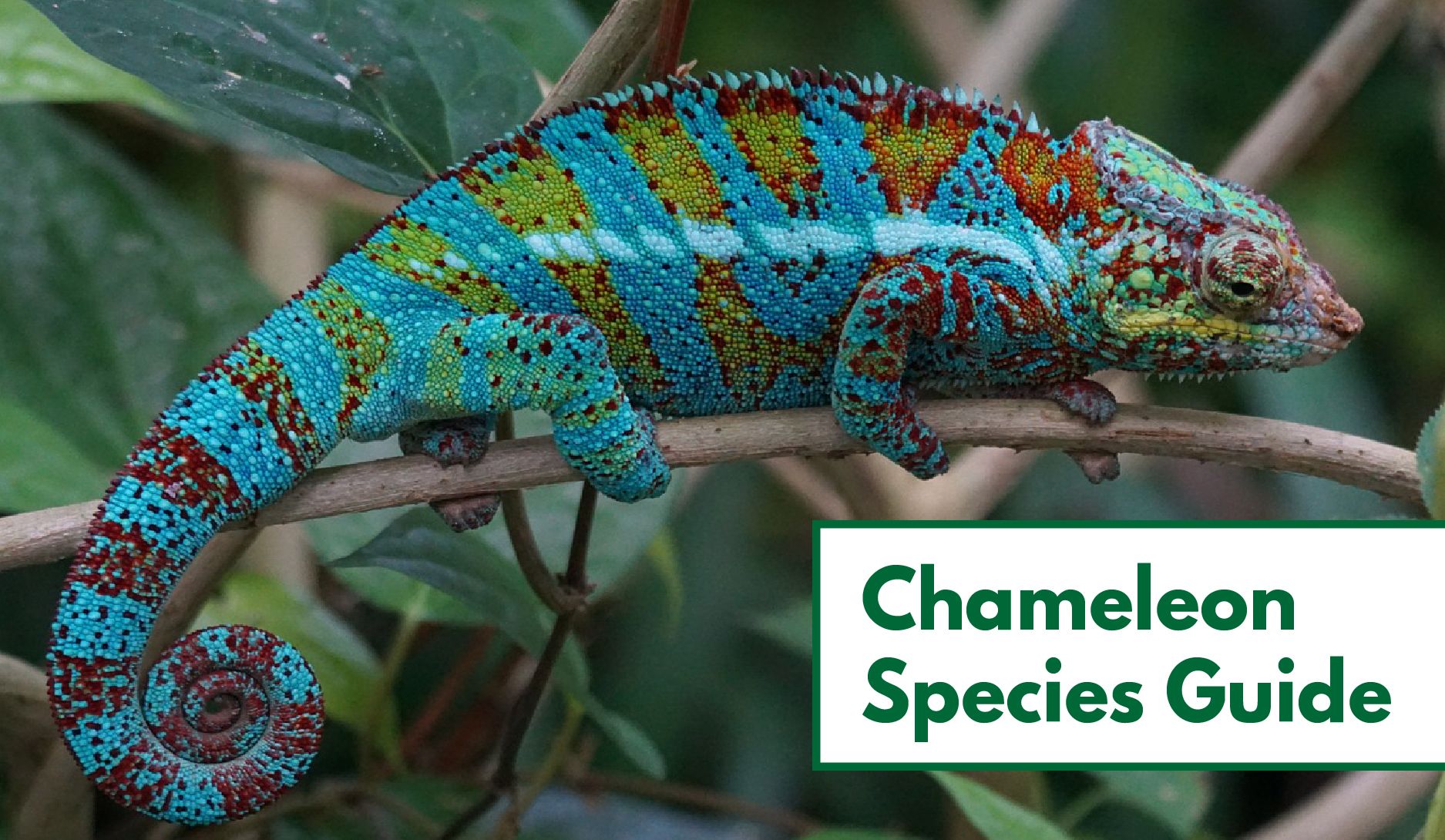
Another distinguishing feature of chameleons is those amazing eyes, which they are able to move in different directions and can “zoom in” on prey like a telephoto lens. This isn’t just really cool, it sets the chameleon apart from every other kind of lizard.
Something else chameleons are known for, of course, is their ability to change color. Every chameleon species is capable of changing color to some extent, though some varieties do it more dramatically than others.
There are more than 150 species of chameleons recognized today, with others still being researched and yet to be named. Before we continue, it’s important to note that the vast majority of these species are not available for sale from pet stores or even specialty breeders. In fact, many are only found in the wild and may even be illegal to export from their native countries.
Quick Navigation
Useful Chameleon Vocabulary
As you read through this guide and conduct additional research about chameleon species, it’s a good idea to make sure you have a basic grasp of some of the common terms you’ll likely come across. Here are some vocabulary words that may be helpful.
- Squamation: A word used to describe the arrangement of scales on a lizard
- Crest: A ridge-like body part that rises from the main body
- Taxonomy: The study of naming and classifying animals and other organisms
- Casque: A helmet-like structure on the head of an animal, sometimes called a “head crest”
- Annulated: Describes markings that are ring-like or circular
- Endemic: Native to a particular area
Types of Chameleons
The first section of this guide will explore chameleon species that are kept as pets. After that, wild species will be categorized by genus.
Pet Chameleon Species
The following species of chameleons are the ones you’re more likely to find in a pet shop or through a breeder. Each has its own unique traits and qualities, and all make excellent pets for lizard enthusiasts.
Carpet Chameleon (Furcifer lateralis)
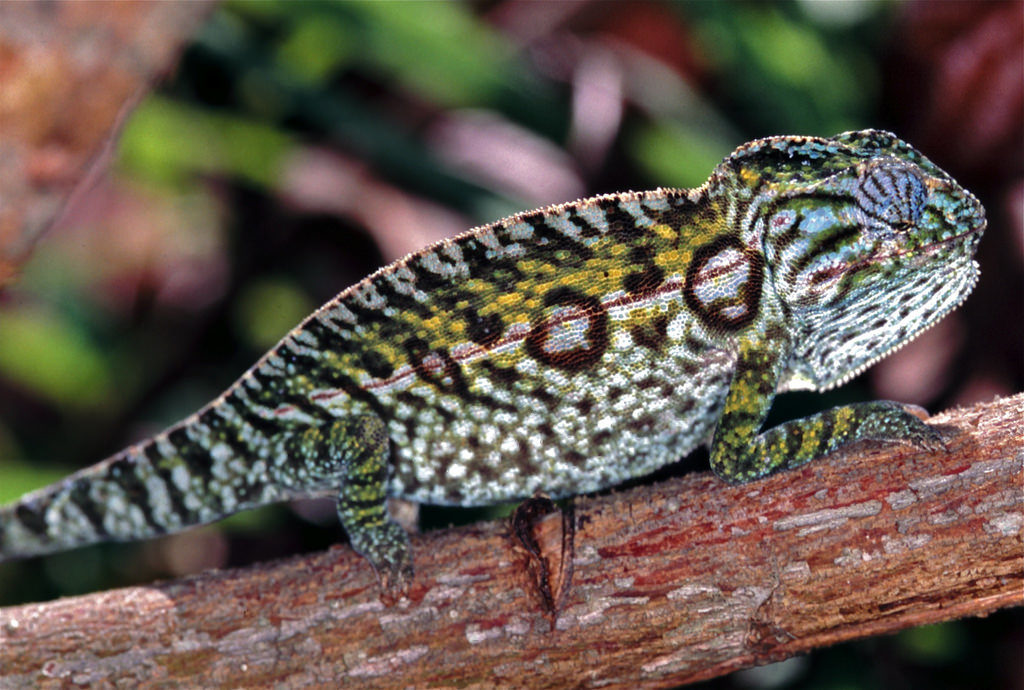
Sometimes called the White-Lined chameleon, this species comes mostly from central Madagascar and belongs to the genus Furcifer. Males are usually green, while females display a wider variety of colors and banding. Carpet chameleon varieties are bred and sold as pets throughout North America and around the world. Carpet chameleons are fairly adaptable, and tend to thrive when properly cared for.
Fischer’s Chameleon (Kinyongia fischeri)

Popular as a pet, the Fischer’s chameleon is native to Kenya and Tanzania. They are often an attractive shade of green and have a pronounced nose-like structure that protrudes from the front of their faces. The species can grow to be around 15 inches long. This species belongs to the recently established genus Kinyongia.
Flap-Necked Chameleon
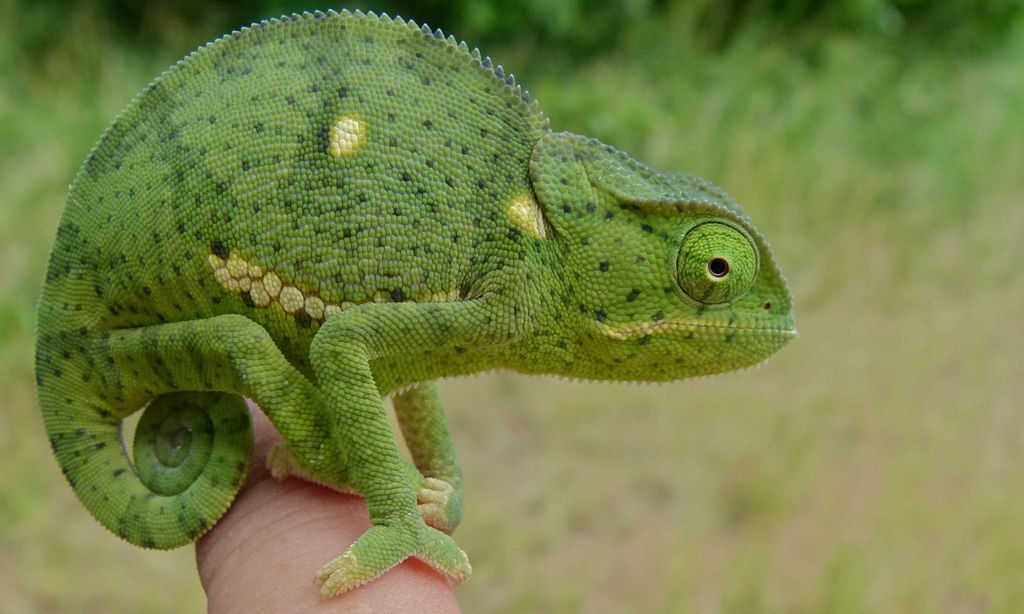
Three Horned (Jackson’s) Chameleon

Native to east Africa, this species can also be seen in the wild in Hawaii – where they were introduced. Characterized by its “horns,” they can grow to be around 13 inches long and have a fairly long lifespan of 8 years. This species is readily available to purchase as a pet, and can be very enjoyable to watch and care for. It is also part of the somewhat newly designated sub-genus Trioceros.
Meller’s Chameleon

Sometimes called a Giant One-Horned chameleon, the Meller’s chameleon is the largest chameleon species not native to Madagascar. It is found in the savannas and interior mountains of East Africa, and can also be found in Tanzania, Malawi, and northern Mozambique. Generally reaching around 24 inches in length, specimens as large as 30 inches have been documented. This species is usually a lovely deep green with white stripes, with a stubby nose-like growth on its face. Meller’s are known to be especially aggressive, and usually don’t do well when placed with other lizards. Like its three and four-horned relatives, this chameleon belongs to the Trioceros sub-genus.
Panther Chameleon
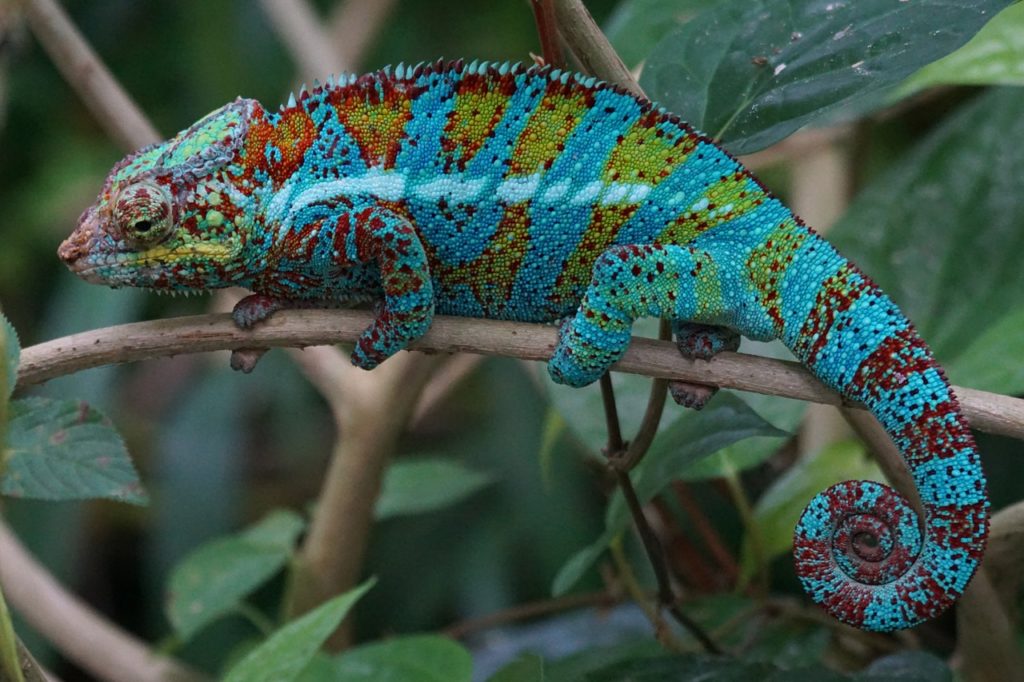
Belonging to the genus Furcifer, these chameleons come in a variety of bright colors. This vivid coloration is part of what makes thd species so popular among lizard hobbyists. While Panther chameleons can perform rapid color changes, they do not change instantly to match any background placed behind them (contrary to what some creatively edited YouTube videos would have you believe). They grow to be anywhere from 10 – 18 inches and can live for up to 7 years when properly cared for.
Veiled Chameleon
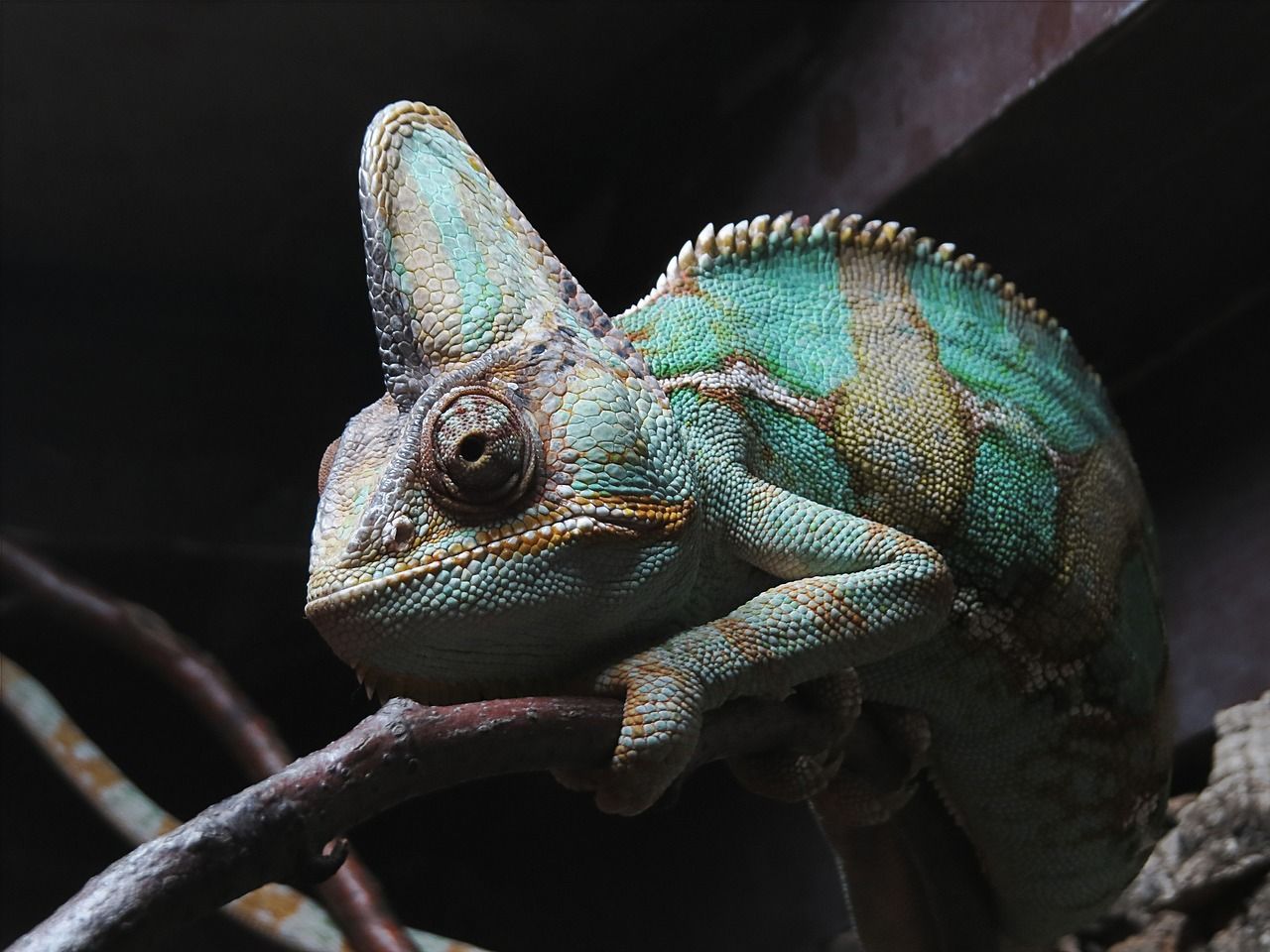
Veiled chameleons, which are also known as Yemen chameleons, belong the genus Chamaeleo. They can get fairly large – up to 2 feet! This species gets its name from the crest atop its head. It is also known for having beautiful, vivid patterning. The Veiled chameleon is a popular pet for reptile enthusiasts and can also be found in the wild. In fact, the Veiled chameleon populates many areas throughout Africa. If you keep one as a pet, it’s best to make sure it has its own enclosure, as the Veiled chameleon has a tendency to be aggressive and territorial when confronted with other lizards.
Outstalet’s Chameleon
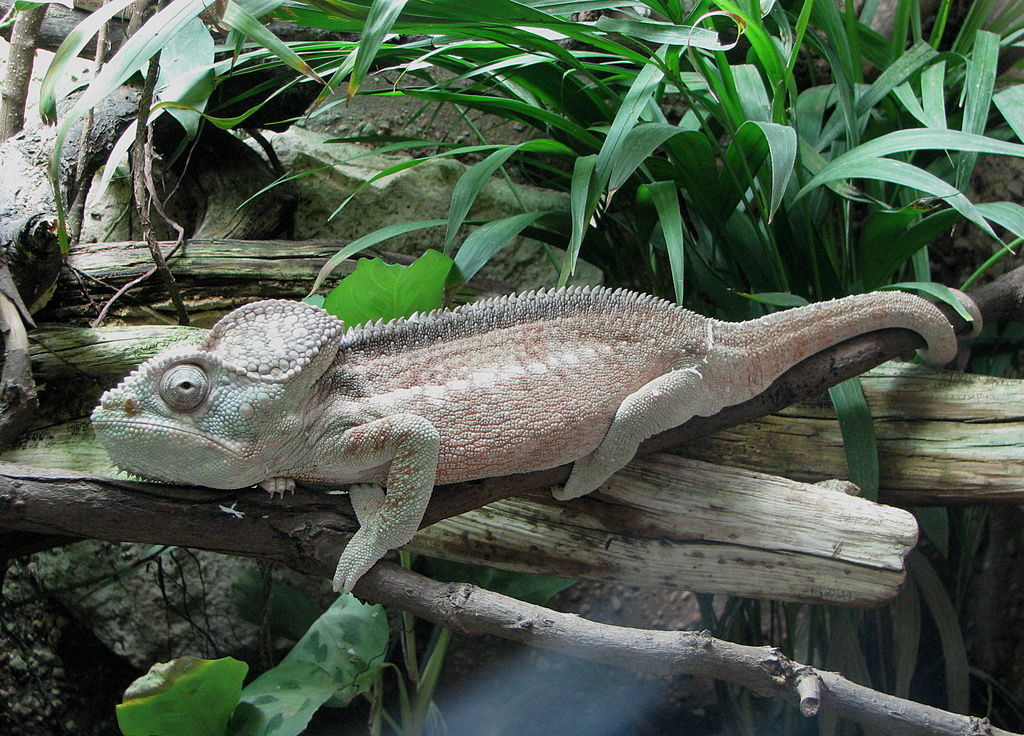
This species is also commonly known as the Malagasy Giant chameleon. These lizards can grow to be over 2 feet long, and are generally considered to be the largest chameleon species. They are often grey-colored, with some light banding along their bodies. If you’re thinking about getting this kind of chameleon for your next pet, make sure you purchase or build an enclosure large enough to accommodate this beautiful giant.
Four-Horned Chameleon
Also native to Cameroon, the Four Horned chameleon is sometimes simply called the Cameroon chameleon or the “quad.” Growing 10-14 inches long, this sail-finned creature’s native habitat is rainforest. It is green and has varied squamation, sometimes displaying purple or blue accent colors. An elongated beard makes this species even more distinctive, as do the namesake horns. However, these lizards do not always show exactly 4 horns, having anywhere from 1 to 6 of them. The Four-Horned chameleon is commonly listed as being part of the genus Chamaeleo, which was accurate at one time. However, it is now considered a part of the genus Trioceros, which is recognized as a sub-genus of Chamaeleo.
Dwarf Chameleons (Bradypodian)
Chameleons within the genus Bradypodian are endemic to southern Africa, are all dwarf chameleons.
Transkei Dwarf Chameleon
Sometimes called the Pondo dwarf, this chameleon is native to the Eastern Cape province of South Africa. This species is almost entirely concentrated within the Port St. Johns area. Because of habitat loss, the Transkei is endangered.
Knysna Dwarf Chameleon
With the longest tail in the Bradypodian genus, the Knysna dwarf chameleon can grow up to 7 inches in length and has a prominent casque. This particular variety usually has skin color ranging from bright green to blue and displays purple, yellow, and even pink markings.
Drakensberg Dwarf Chameleon
This small chameleon is usually light brown in color, with the exception of bright blue-green tubercles (tiny bumps) on its upper limbs and flanks. Sometimes, it will display some light blue coloring on the top of its cheeks and the top of its head.
Robertson Dwarf Chameleon
Also called Little Karoo, this is a medium sized dwarf chameleon that grows no larger than six inches. This species lives in the Western Cape province and generally appears grayish or olive in color. Unlike their forest-dwelling relatives, Robertsons eat the low-growing fynbos shrubs that are abundant in South Africa. There is some evidence suggesting that the Robertson may have split off from the forest-dwellers millions of years ago, adapting its diet as the forests fell back, giving way to dry fynbos.
Black-Headed Dwarf Chameleon
Found in KwaZulu-Natal, South Africa, this species is sometimes called the KwaZulu dwarf chameleon. They are generally brownish in color with darker colored heads. Despite the name, Black-Headed dwarfs do not actually have fully black-colored heads.
Cape Dwarf Chameleon
This species is mostly green with orange markings on its body and head. The males are brighter green, while the females tend to be duller. This is one of the chameleon species that gives live birth, rather than laying eggs.
Setaro’s Dwarf Chameleon
One of the smaller dwarf chameleons, Setaro’s varieties don’t get more than 4 inches long. They also haven a smaller throat crest than other varieties.
Smith’s Dwarf Chameleon
This African dwarf chameleon is one of the species that uses its color changing capabilities as a method of camouflage.
Natal Midlands Dwarf Chameleon
Closely related to the Black-Head dwarf, this is a particularly small dwarf chameleon. The Natal Midlands variety only grows to about 3 inches long. It has distinctive multi-colored squamation across its body. It has a yellow head crest and white throat. Further distinguishing this species is the orange stripe displayed by males.
Transvaal Dwarf Chameleon
Native to South Africa and Swaziland, this species is usually found in forested areas located at high elevations on mountains or plateaus. Transvaals may also be found in deep gorges and stand out because of their bright colors, often displaying vivid reds and oranges.
Namaqua Dwarf Chameleon
Also called the Western dwarf chameleon, the Namaqua dwarf prefers to live in beach plants on the West coast of Namibia and South Africa. Fairly large for the genus, this species can grow up to more than six inches long. The Namaqua is a bit thicker, too, and with a shorter tail. The coloring for a Namaqua is usually a fairly dull brownish or grayish with some mottling. A distinguishing feature of this variety is the series of grooves that runs along their chins.
Genus: Chamaeleo
Chameleon species from the Chamaeleo genus display all the most recognizable chameleon characteristics, such as the curling prehensile tail. Most pet chameleons on the market today belong to Chamaeleo.
Two-Lined Chameleon
Also referred to as the Two-Striped or Side-Striped chameleon, this species is endemic to Sudan, Ethiopia, Tanzania, Somalia, Kenya, Uganda, and parts of the Democratic Republic of the Congo. It is often brownish in color, showing a set of broken white stripes down each side of its body.
Veiled Chameleon
Veiled chameleons, which are also known as Yemen chameleons, can get fairly large – up to 2 feet! This species gets its name from the crest atop its head. It is also known for having beautiful, vivid patterning. The Veiled chameleon is a popular pet for reptile enthusiasts and can also be found in the wild. In fact, the Veiled chameleon populates many areas throughout Africa. If you keep one as a pet, it’s best to make sure it has its own enclosure, as the Veiled chameleon has a tendency to be aggressive and territorial when confronted by other lizards.
Jeweled Chameleon
Also called the Madagascar Forest chameleon and Campan’s chameleon, this is a fairly small lizard (it grows to about 5 inches). From the central highlands of Madagascar, the Jeweled chameleon is considered a threatened species due to habitat loss. Known for its striking appearance, the Jeweled chameleon is usually some shade of green with lateral striping and beautiful bright-colored spots.
Common Chameleon
The Common chameleon is also called the Mediterranean chameleon. Ranging from bright green to dull brown, this species is particularly adept at color-changing. Females will show exquisite spotting during mating season, ranging in color from yellow and orange to green. The Common chameleon has the widest range of any chameleon species, and native populations can be found from northern Africa to southern Europe and southeast Asia.
Giant Three-Horned Chameleon
As indicated by the name, the Giant Three-Horned chameleon is large and has three horn-like structures protruding from its head. Native to East Africa, this species has been introduced in Hawaii, Florida, and California.
Three Horned (Jackson’s) Chameleon
Native to east Africa, this species can also be seen in the wild in Hawaii – where they were introduced. Characterized by its “horns,” this chameleon can grow to be around 13 inches long and have a fairly long lifespan of 8 years. This species is readily available to purchase as a pet, and is very enjoyable to watch and care for.
Flap-Necked Chameleon
The Flap-Necked chameleon is one of the most highly traded chameleon species in the world. In the wild, it can be found throughout most of Sub-Saharan Africa. It is highly adaptable, and can be found in forest areas, wet or dry savannas, grasslands and woodlands, and has even been known to spread into rural and suburban places. This chameleon makes a great pet and is fairly easy to care for.
Fischer’s Chameleon
Popular as a pet, the Fischer’s chameleon is native to Kenya and Tanzania. They are often an attractive shade of green and have a pronounced nose-like structure that protrudes from the front of their faces. The species can grow to be around 15 inches long.
Graceful Chameleon
Found naturally throughout Central Africa, the Graceful chameleon ranges in color from green to yellow to brown. They can grow up to 15 inches in length and have a green stripe running the length of their bodies. The males of the species are usually quite territorial, and display dramatic color changes when they feel threatened. When females are seeking a mate, they will show yellow or orange colored spots.
Elephant-Eared Chameleon
Also known as the Short-Horned chameleon, this species has large occipital lobes that resemble oversized ears. Males display a short, bony appendage which extends from their nose area. Their coloring ranges from a dull gray to striking shades of blue and green. There is much variation between Elephant-Eared chameleons found in different localities, including notable size differences, which has led some researchers to believe that this species may actually be comprised of several closely related – but different — species.
High Casqued Chameleon
This type of chameleon is known by several names, including the Helmeted chameleon and Von Hoehnel’s chameleon. They are found in the wild throughout eastern Africa. This is a small-medium chameleon, getting up to around 10 inches in length at maturity. This species can be seen in a wide array of color variations. They display a single horn, a serrated back crest, and a spiny throat crest.
Johnston’s Chameleon
Another three-horned variety, the Johnston’s chameleon is sometimes called the Ruwenzori chameleon. It is native to Uganda, Rwanda, Burundi and the Democratic Republic of Congo. Though they are sometimes sold as pets, they are not as readily available as some other pet chameleon species.
Meller’s Chameleon
Sometimes called a Giant One-Horned chameleon, the Meller’s chameleon is the largest chameleon species not native to Madagascar. It is found in the savannas and interior mountains of East Africa, and can also be found in Tanzania, Malawi, and northern Mozambique. Generally reaching around 24 inches in length, specimens as large as 30 inches have been documented. This species is usually a lovely deep green with white stripes, with a stubby nose-like growth on its face. Meller’s chameleons are known to be especially aggressive, and usually don’t do well when placed with other lizards.
Cameroon Sailfin Chameleon
Also known as the Cameroon Two-Horned Mountain chameleon, this species is generally found only in rainforests within the Cameroon highlands with an elevation ranging from 700 – 1900 feet. However, they have been known to migrate to nearby farms and plantations. Usually green, this species has two large horns and a large dorsal sail.
Namaqua Chameleon
A ground-living chameleon native to areas around Namibia, Africa and southern Angola, the Namaqua is one of the area’s largest chameleon species. The Namaqua grows to be about 10 inches long, and its tail is notably shorter than its body. It is generally gray or brown in color with lighter patches throughout, punctuated by yellow or red stripes around the throat. It also has large dorsal spines and a prominent casque.
Owen’s Chameleon
Sometimes called Owen’s Three-Horned Chameleon, this species is endemic to Sub-Saharan Africa. Males display crests and three horns. This is a fairly large species, growing to be almost a foot long.
Pfeffer’s Chameleon
The Pfeffer’s chameleon is endemic to the highlands of Cameroon, Africa. There are currently less than a dozen known populations of this species in the world, isolated to remnants of forest lands. Continued forest degradation threatens remaining populations, and they are protected from capture or slaughter by the Cameroonian government.
Four-Horned Chameleon
Also native to Cameroon, the Four Horned chameleon is sometimes simply called the Cameroon chameleon or the “quad.” Growing 10-14 inches long, this sail-finned creature’s native habitat is rainforest. It is green and has varied squamation, sometimes displaying purple or blue accent colors. An elongated beard makes this species even more distinctive, as do the namesake horns. However, these lizards do not always show exactly 4 horns, having anywhere from 1 to 6 of them.
Senegal Chameleon
This species is found in Nigeria, Cameroon, Mali and, of course, Senegal. It is usually olive colored, and about 9 or so inches in length. In this species, the female is generally larger than the male.
Tiger Chameleon
The Tiger chameleon grows to about six inches long in adulthood and comes in an array of colors that often includes gray, orange, green, or brown. Its most distinguishing features are the grouping of spikes on its chin and the long, pointy protrusion on its chin.
Werner’s Chameleon
Brown and green, Werner’s chameleon is native to the forests of Udzungwa and the mountains of Tanzania’s Eastern Arc. They usually grow to be around a foot long and have a distinctive fused occipital lobe. Males have three annulated horns on their heads. Females have just one.
Rhinoceros Chameleon
Named for its horn-like nose (which is especially prominent in males), this species grows to be around 11 inches long. It has a small crest on its head, as well as a crest running partway down its back. The Rhino’s coloring is generally dull, mostly gray or light brown with a blue-tinted snout and a white line that runs down the sides of its body. Native to western Madagascar, where it lives in dry forests, the Rhinoceros chameleon’s habitat is threatened by deforestation and the species is considered vulnerable.
African Chameleon
Also known as Sahel chameleon, this variety is endemic to dry savannah areas of the Sahel in Africa. Fairly large, this chameleon species grows up to 18 inches in length. It is usually green with an array of black spots and a large, bony casque on its head.
Smooth Chameleon
This bluish green chameleon species is found in lowlands throughout Sub-Saharan Africa, and is distinguished by being very slender compared to many other chameleon species.
Genus: Rhampholean
Lizards from the genus Rhampolean are native to Africa and are all relatively small in size.
Tanzania Stump-Tail Chameleon
Stump-tailed chameleons are fairly small, and have short tails in relation to the rest of their bodies. They are often grey or brown in color. While they don’t have horns, they do have a “rosette-like appendage” and spiky enlarged scales on their limbs and flanks. Because of their size, these types of chameleons are often wrongly believed to be pygmy chameleons.
Marshall’s African Leaf Chameleon
Also called Marshall’s Leaf chameleon and Marshall’s pygmy chameleon, this species is found in Mozambique and Zimbabwe. It is a small forest-dwelling chameleon, only growing to about 1 ½ to 3 inches long. Its name comes from the way it resembles a leaf when it sits still on tree branches.
Spectral Pygmy Chameleon
Found in the rainforests and coastal lowlands of central and western Africa, this chameleon species is also quite small. Reaching a length of around 3 ½ inches, this species has a distinctive high, flat body shape
Genus: Brookesia
Commonly known as Leaf Chameleons, species belonging to the genus Brookesia are endemic to Madagascar. They are all fairly small, and many of the species within this genus were only discovered within the last few decades.
Decary’s Chameleon
A rare species, Decary’s chameleons are found only in Madagascar. Unfortunately the only known population is in decline due to habitat loss; these animals are condsidered endangered.
Nosy Be Pygmy Chameleon
One of the smallest four-legged animals in the world, this species is one of the more recently discovered among chameleons. Name for the Nosy Be Forest (??) in which it is found, and the most distinguishing feature of this forest-dwelling chameleon is its tiny stature. Nosy Be pygmy chameleons grow to be only ½ inch to just over an inch tall.
Antongil Leaf Chameleon
Also distinguished by their minimal size, Antongil Leaf chameleons are from northeastern Madagascar. As a result of deforestation, populations of this species have become smaller and more fragmented. Because of this, they are considered endangered.
Armored Leaf Chameleon
You may see the Armored Leaf referred to as the Antsingy Leaf (both are correct). This chameleon is the largest of the Brookesia genus, reaching a length of up to 11 cm..They are brown and spiny, and can easily blend in with the leaves on the forest floors of its native It is northeastern Madagascar. Unfortunately, habitat loss is to blame for the “endangered” status of this species.
Dead Leaf Chameleon
This chameleon is sometimes called the Brown Leaf chameleon. These names come from the creature’s appearance. Their coloration – brown, green, dark red, olive, or combinations of these – and their high, flat bodies do make them resemble a dead leaf. Native to eastern Madagascar, these small chameleons have impressive horns and spiny scales.
Mossy Leaf Chameleon
The Mossy Leaf, or Iaraka River chameleon is a unique looking specimen from Madagascar. The elaborate pattern and coloring (usually ever-changing combinations of greens and browns) leave no question about how this species got its name.
Thiel’s Pygmy
Also found in eastern Madagascar, this species is very small and easily able to blend in with its densely forested habitat. While it is not endangered, there is concern about conservation of this species due to rapid loss of forest lands in Madagascar.
Genus: Furcifer
Like the Brookesia genus, chameleons belonging to Furcifer are mostly endemic to Madagascar.
Labord’s Chameleon
The Labord’s chameleon is from southwestern Madagascar. This species is distinguished by having the shortest lifespan of any four-legged vertebrate. Once it hatches, this chameleon lives for about 4 to 5 months.
Lesser Chameleon
Unlike many other chameleon species, the female Lesser chameleon is the more colorful of the two sexes, displaying green and yellow bands along with yellow speckling. Males usually have duller coloration, often with black and white banding. They mostly inhabit forested areas in Madagascar, but have been known to thrive elsewhere, with populations cropping up in farmlands and plantations surrounding their native habitat.
Carpet Chameleon
Sometimes called the White-Lined chameleon, this species comes mostly from central Madagascar. Males are usually green, while females display a wider variety of colors and banding. Carpet chameleons are bred and sold as pets throughout North America and around the world.
Tusked Chameleon
Male Tusked chameleons can reach a length of 19 inches upon maturity. The pointed rostal appendages apparent on male specimens are what give this species its name. These chameleons range in color and patterning, with some displaying solid bright green coloring and others having dark bands.
Angel’s Chameleon
From northwest Madagascar, this chameleon species is usually brown or grayish and has a distinctive spike at the front of its head. Often, the Angel’s chameleon also has white stripes down the sides of its body.
Panther Chameleon
Panther chameleons come in a variety of bright colors, and are one of the types of chameleon commonly bred and sold as pets. They grow to be anywhere from 10 – 18 inches and can live for up to 7 years when properly cared for.
Spiny Chameleon
Sometimes called Warty chameleon or Crocodile chameleon, this species has a distinctive casque and small ridges running between its eyes and snout. This is in addition to the namesake spines that run along its back. It is usually gray or brown, with some darker mottling and a non-solid white stripe running down each side of its body.
Outstalet’s Chameleon
This species is also commonly known as the Malagasy Giant chameleon. These lizards can grow to be over 2 feet long, and are generally considered to be the largest chameleon species. They are often grey-colored, with some light banding along their bodies.
Wills’ Chameleon
The Wills’ chameleon (also known as the Canopy chameleon) is usually green and white with some brown markings. Native to Madagascar, it is known to prefer high altitudes and mild temperatures.
Petter’s Chameleon
This species is usually green brilliant green in color, with lateral white stripes and striking white lips. They grow to be an average of about 6 inches long, with females displaying especially striking color changing abilities. Males of this species have a noticeable nub protruding from its face. Some people keep this species as pets, though they are generally considered an ideal choice for only expert level reptile enthusiasts.
Genus: Calumma
The genus Calumma is restricted only to Madagascar and is named after the Greek “kalymma,” which means veil or hood. This is because of the prominent occipital lobes displayed by species in the genus.
Side-Striped Chameleon
This species is sometimes called the Perinet chameleon, and is known for its bright green coloring. Pale stripes run the length of its body on each side. There are actually three recognized subspecies of the Side-Striped chameleon.
Short-Horned Chameleon
Short-Horned chameleons have distinctive occipital lobes, with males possessing a bony appendage which protrudes from their nose. They are small, and usually brownish or grayish in color although variations exist within the species (some even have blue legs).
Nose-Horned Chameleon
You may hear this species referred to as the Big-Nosed chameleon. They are small and get their common names from the long nose-like appendage that projects from the front of its face. Researchers have also identified a Bizarre-Nose chameleon species within the Calumma genus, which is similar but separate.
O’Shaughnessy’s Chameleon
Native to the central highlands of Madagascar, O’Shaughnessy’s chameleon is usually brownish-grey with darker patches around the neck area. Males have a short, bony protrusion on their noses and grow to be around 15 inches long.
Boettger’s Chameleon
This chameleon, also called the Blue-Nosed chameleon, is fairly small (they grow to be no more than 5 inches long). They are usually brown, brownish-green, and brownish-yellow. Some specimens display striking blue spots.
Hooded Chameleon
While sometimes confused by name with the Veiled chameleon, the Hooded chameleon is a unique species from northeast Madagascar. Unlike the former, the latter is considered a vulnerable species and is generally not available on the pet market.
Malthe Chameleon
Native to the mountain cloud forests and rainforests of eastern Madagascar, the Malthe chameleon is distinguished by its large occipital lobe and nose-like appendage apparent in male specimens. During mating season, females display striking blue markings surrounding the occipital lobes and covering the eyelids.
Parson’s Chameleon
One of the largest chameleon species, Parson’s chameleon has two recognized subspecies – one of which can grow to be 27 inches long. They can be seen in a wide array of color variations, and have one of the longest life-spans of any chameleon. A healthy Parson’s chameleon can live for nearly a decade.
Globe-Horned Chameleon
Globe-Horned chameleons may also be called Flat-Casqued chameleons. They have two bulbous appendages on the front of their faces, which may be hard to distinguish unless you are looking at them head-on.
A Few More Things You Should Know
Here are a couple of key things to be aware of as you study chameleons, especially if you are considering keeping a chameleon for your next pet.
- It’s important to remember that taxonomy is an ever-evolving field, and things are always changing in the world of classifying and naming animal species.
- While a particular species may be endemic to a certain area, many have been successfully introduced to the wild in other parts of the world. Additionally, many are bred in captivity for conservation and as pets.
- Since there are so many types of chameleons out there, some breeders are misinformed about which ones they are actually selling. Worse, unscrupulous sellers may intentionally mislead buyers about which chameleon species they are buying.
- Beware of anyone who claims to be selling illegal or endangered animals. It’s likely that this is just a gimmick to get customers to pay more for what they believe to be a rare specimen. If the breeder is, in fact, selling black market lizards – don’t do business with them!